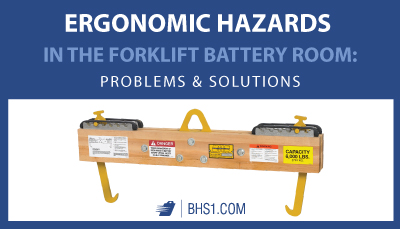We use cookies to make your experience better. To comply with the new e-Privacy directive, we need to ask for your consent to set the cookies. Learn more.
Ergonomic Hazards in the Forklift Battery Room: Problems and Solutions
Addressing major hazards in the battery room like fires, explosions, and acid burns can lead some managers to neglect the smaller ergonomic issues. Unfortunately, these small issues can also become big problems when left unaddressed.
Luckily, common-sense precautions allow battery-room managers to protect employees from both kinds of risk. Here are some straightforward ways to address recurrent ergonomic issues in the battery room.
Let machines do the hard work with battery-changing equipment.
The most obvious ergonomic improvement managers can make to a battery room is using specialized equipment that makes changing forklift batteries easier. Outdated or inappropriate battery handling equipment can lead to back injuries from lifting and twisting. It also increases the chances of batteries falling, which can be dangerous and costly. 
Vertical-extraction forklift fleets require gantry cranes built specifically to handle forklift batteries, complete with Battery Lifting Beams to ensure stability during changes.
For smaller operations with side-extraction fleets, a battery carriage uses a hydraulic push-pull extraction to change batteries. The carriage mounts to a pallet truck so transporting the battery to a charger is a safe and easy process.
For larger side-extraction operations, an Operator-Aboard Battery Extractor makes change-outs safer and faster than ever. Each model has different safety features, but all of them let the machine do the hard work while staff oversees the process.
Reduce bending and untangling with good cable management.
Tangled cables may not seem like an ergonomic risk, but they are symptomatic of a larger problem. Poor cable management means staff has to bend and untangle cables repeatedly. This leads to productivity losses, and it can also lead to musculoskeletal disorders due to repetitive motions.
To make matters worse, cables that are repeatedly bent, kinked, and tangled are more likely to be worn out and pose an electric-shock threat. The chances of tripping also greatly increase when messy cables litter the floor.
With simple, heavy-duty cable management equipment, cords can stay untangled and retracted when not in use. Good cable management speeds up the charging process, keeps staff safer, and even saves money by increasing the longevity of cords.
Allow easy maintenance with well-designed charger stands and drip pans.
Another hidden ergonomic danger involves maintenance to drip pans. When staff has to contort themselves for cleaning, injury risks increase. Non-removable drip pans also increase the likelihood that routine preventative maintenance will be avoided because of the hassle it involves. Removable drip pans let staff quickly dispose of accumulated electrolyte without unnecessary bending and kneeling.
Similarly, when chargers are hard-to-reach, maintenance tasks can be difficult and dangerous.
Relying on charger stands that provide direct access to chargers makes life easier for whomever needs to access the charger. Making maintenance tasks quick and easy keeps staff happier and safer and allows them to accomplish more in a day.
Keep batteries watered with integrated watering systems or watering guns.
Watering batteries is another crucial process that battery-room designers can make easier. Instead of forcing staff to climb or reach to access battery cells, operations can rely on integrated systems that automatically water batteries to the appropriate level. These systems free up staff for other tasks and can more precisely keep electrolyte at the correct level.
Even a simple device like a watering gun with an automatic shutoff allows staff to water batteries from a safe distance in a comfortable stance. Small tweaks like these can give an employee's back a well-needed break.
Communicate with staff and respond to their needs.
Staff feedback gives managers insight into what processes can be improved. If employees complain that a task is hard on their body, listen to them. By addressing their situation, you'll reduce turnover and injuries, and you'll likely improve productivity by getting rid of a bottleneck.
Managers don't necessarily need to buy new equipment to improve ergonomics. Rotating employees out of stressful tasks and teaching good lifting form are lower cost ways to keep staff healthy. However you address an employee's ergonomic request, you'll show them that you're listening and that you're responsive to their needs.
References:
"Powered Industrial Trucks (Forklift)." OSHA. Occupational Safety and Health Administration, U.S. Department of Labor, n.d. Web. 13 Sept. 2017.
"Worker Safety Series: Warehousing." OSHA. Occupational Safety and Health Administration, U.S. Department of Labor, 2004. PDF. 13 Sept. 2017.
